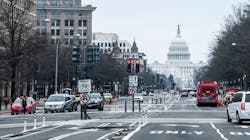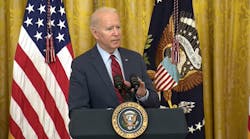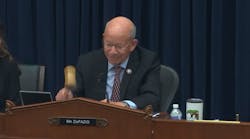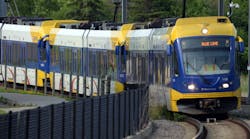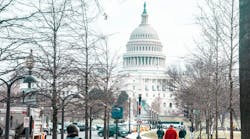INVEST in America Act passes House with $109 billion for transit
The U.S. House has passed the five-year $715 billion INVEST in America Act. Those who crafted the legislation say the investments included in the bill are needed to rebuild U.S. infrastructure and make the country more competitive on a world stage.
The “transformational legislation lays the groundwork for President [Joe] Biden’s vision on infrastructure” and includes $343 billion in roads, bridges and safety investments, $109 billion in transit investments and $95 billion in passenger and freight rail investments.
“The American people are sick and tired of potholes, getting stuck in traffic, delayed buses and slow trains, lead-tainted pipes and sewers that back up—the result of decades of underinvestment in our infrastructure, our communities and our future,” said Chair of the House Committee on Transportation and Infrastructure Peter DeFazio (D-OR-4). “The good news is that this is an American problem America can fix. By passing the INVEST in America Act today, the House took a bold and badly-needed step to build for the future, tackle the existential threat of climate change by modernizing our transportation systems to cut carbon pollution and improve the lives of hundreds of millions of people.
Deeper look at investments included
Within the $343 billion for roads, bridges and safety is $13 billion for Projects of National and Regional Significance, which is a rebranded INFRA grant program; $4 billion for clean corridors that include electric vehicle charging and hydrogen fueling; $560 million for ferry boats and ferry terminals; and $1 billion for active transportation grants.
Within the $95 billion for passenger and freight rail is $32 billion for Amtrak’s national network and Northeast Corridor; $25 billion in high-speed rail and intercity passenger rail grants, known as PRIME; $25 billion for bridges, stations and tunnels; $7 billion for CRISI and Research and Development grants; and $2.5 billion for grade-crossing separations.
The $109 billion in transit investments include:
• $40.5 billion: Urbanized and Rural Area Formula Grants
• $24 billion: State of Good Repair Grants
• $21.5 billion: Capital Investment Grants
• $11 billion: Bus and Bus Facilities, including over $4 billion for zero-emission buses
• $2 billion: Enhanced Mobility of Seniors and Individuals with Disabilities
• $1 billion: All Stations Accessibility Programs Grants (Americans with Disabilities Act Grants)
• $1 billion: Reducing Transit Deserts
• $416 million: Bus Frequency/Ridership Competitive Grants
• $134 million: Transit Supportive Communities
At a June 30 press conference ahead of the House vote on the legislation, Chair DeFazio highlighted the bill’s 140 percent increase in transit investment and the requirement that states not default to highway expansion as a first line of congestion relief.
“We built 35,000 miles of highways in our 100 largest cities in the last 20 years. And guess what? Congestion is six times worse. That is not the solution,” said Chair DeFazio. “We’re going to make states look at alternatives. Rail, transit, micro transit. All the other things that can work.”
The INVEST in America Act also includes $5.6 billion for 1,473 Member Designated Projects of which 237 are transit specific.
The bill now moves to the Senate, which has its own version of surface transportation reauthorization making its way through the upper house. Further complicating the infrastructure debate is the $1.2-trillion, eight-year bipartisan infrastructure deal reached last week between the Biden Administration and a group of 10 senators.
At the same June 30 press conference, Chair DeFazio said the bipartisan deal had “good numbers” but noted its an outline without policy attached to the proposal. However, he did mention he was encouraged by the bipartisan deal’s progress.
Reactions overwhelmingly supportive
The American Public Transportation Association (APTA) called the bill a “generational and transformational piece of legislation.”
“It puts us on the path to increase access to opportunities for all Americans and build more equitable communities. The INVEST in America Act also addresses the environmental and sustainability challenges facing our communities, nation and the world. H.R. 3684 also reflects key pillars of APTA’s Surface Transportation Authorization Recommendations, addressing the $105 billion state-of-good-repair backlog and providing the necessary investment to meet growing demand by funding all projects in the Capital Investment Grant pipeline,” said APTA President and CEO Paul P. Skoutelas. “The passage of the INVEST in America Act is a vital and necessary step to provide the transformational investment in infrastructure the country so desperately needs.”
The California Transit Association says the investments included in the bill will modernize transportation infrastructure, while increasing access and mobility for working families.
“By bringing our transit and rail systems into a state of good repair and supporting zero-emission technologies and deployment, we will fast-track the transformation of our nation’s transportation sector into one that is cleaner, more resilient and equitable. The bill includes $204 billion for transit and passenger and freight rail, including an unprecedented $4 billion investment in zero-emission transit buses, a key priority for California’s transit agencies,” said the association’s Executive Director Michael Pimentel.
Metropolitan Transportation Authority (MTA) Chairman and CEO Patrick J. Foye said the passage of the bill in the House was “an important first step toward new, once-in-a-generation levels of funding for public transportation” but believes more should be done to support MTA’s projects.
“Robust federal support is also needed for MTA's huge portfolio of projects to expand accessibility, modernize signal systems, finish the long-awaited expansion of the Second Avenue Subway to Harlem, build Penn Station Access and its four new Metro-North stations in the Bronx and help transition the MTA bus fleet to zero emissions by 2040,” said Foye. “Federal funds also should be made available to kickstart efforts to reconstruct existing Penn Station and expand Penn Station to increase capacity between New York and New Jersey in tandem with the Gateway Hudson Tunnel Project. We urge Congress to ensure this level of funding is – at a minimum – preserved as both the House and Senate come to a final deal that will work for all transit agencies."
Corinne Kisner, executive director of the National Association of City Transportation Officials (NACTO), said, “The INVEST Act commits to changing the outcomes that our transportation system delivers. From fixing existing infrastructure to making smart investments in transit, safety and climate, this bill is the strongest proposal yet. As the White House and Senate debate the dollar amounts in a potential infrastructure package, NACTO urges following the House’s policy-based approach.”

Mischa Wanek-Libman | Group Editorial Director
Mischa Wanek-Libman is director of communications with Transdev North America. She has more than 20 years of experience working in the transportation industry covering construction projects, engineering challenges, transit and rail operations and best practices.
Wanek-Libman has held top editorial positions at freight rail and public transportation business-to-business publications including as editor-in-chief and editorial director of Mass Transit from 2018-2024. She has been recognized for editorial excellence through her individual work, as well as for collaborative content.
She is an active member of the American Public Transportation Association's Marketing and Communications Committee and served 14 years as a Board Observer on the National Railroad Construction and Maintenance Association (NRC) Board of Directors.
She is a graduate of Drake University in Des Moines, Iowa, where she earned a Bachelor of Arts degree in Journalism and Mass Communication.
